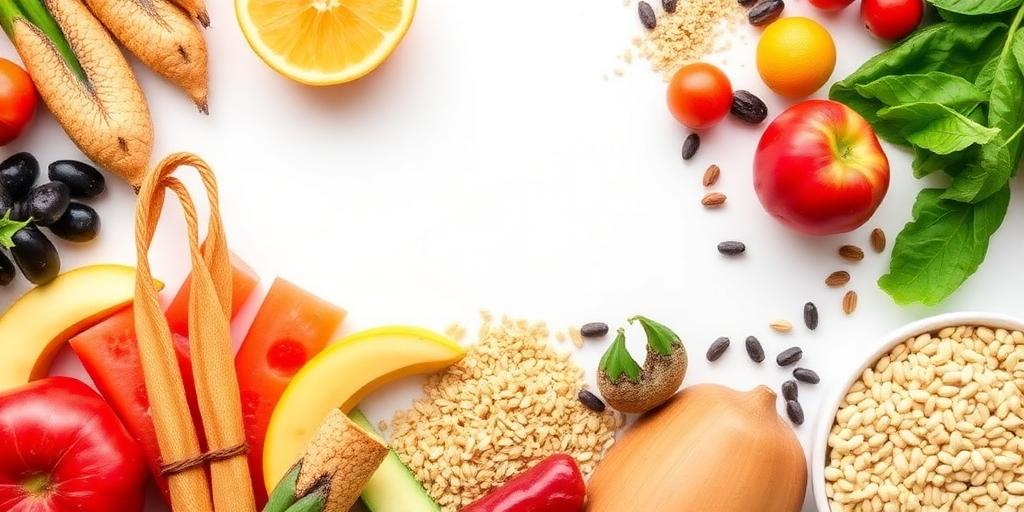The Role of Fiber in a Healthy Diet (2025 Update)
Fiber is a crucial component of a healthy diet, often underestimated but vital for overall well-being. This comprehensive guide, updated for 2025, explores the multifaceted benefits of fiber, its various types, recommended intake, and practical strategies for incorporating it into your daily meals.
What is Fiber?
Fiber, also known as roughage or bulk, refers to the non-digestible parts of plant-based foods. Unlike carbohydrates, proteins, and fats, fiber isn't broken down and absorbed into the bloodstream. Instead, it passes relatively intact through your digestive system, providing a range of health benefits along the way.
Types of Fiber
There are two main types of fiber:
- Soluble Fiber: This type dissolves in water to form a gel-like substance. It can help lower blood cholesterol and glucose levels. Good sources include oats, peas, beans, apples, citrus fruits, carrots, and barley.
- Insoluble Fiber: This type promotes the movement of material through your digestive system and increases stool bulk, so it can be of benefit to those who struggle with constipation or irregular stools. Whole-wheat flour, wheat bran, nuts, beans, and vegetables, such as cauliflower, green beans, and potatoes, are good sources of insoluble fiber.
Many foods contain both soluble and insoluble fiber. Generally, it’s best to eat a variety of fiber-rich foods to get the benefits of each type.
Benefits of Fiber
Consuming adequate fiber offers numerous health advantages:
- Improved Digestive Health: Fiber adds bulk to the stool, preventing constipation and promoting regular bowel movements. It also supports a healthy gut microbiome, which is essential for overall health.
- Weight Management: High-fiber foods tend to be more filling than low-fiber foods, so you're likely to eat less and stay satisfied longer. Fiber can also slow the absorption of sugar, which helps control blood sugar levels.
- Reduced Risk of Chronic Diseases: Studies show that high-fiber diets are associated with a reduced risk of heart disease, type 2 diabetes, and certain types of cancer, particularly colon cancer.
- Cholesterol Control: Soluble fiber can help lower LDL cholesterol levels by interfering with the absorption of dietary cholesterol in the intestines.
- Blood Sugar Regulation: Fiber, particularly soluble fiber, can help slow the absorption of sugar and improve blood sugar levels, which is especially beneficial for people with diabetes.
Recommended Daily Intake
The recommended daily intake of fiber varies based on age and gender. Here are the general guidelines:
- Adult Men: 30-38 grams per day
- Adult Women: 21-25 grams per day
Most people only consume about half the recommended amount of fiber. Gradually increasing your intake can help you achieve these goals and minimize potential digestive discomfort.
How to Incorporate More Fiber into Your Diet
Adding more fiber to your diet doesn't have to be a chore. Here are some practical tips:
- Choose Whole Grains: Replace refined grains (white bread, white rice) with whole grains (whole wheat bread, brown rice, quinoa).
- Eat More Fruits and Vegetables: Aim for at least five servings a day. Leave the skin on when possible, as it contains fiber.
- Include Legumes: Add beans, lentils, and peas to soups, salads, and main dishes.
- Snack Smart: Opt for high-fiber snacks like fruits, vegetables with hummus, or a handful of nuts.
- Read Food Labels: Check the fiber content of packaged foods and choose products with at least 3 grams of fiber per serving.
- Start Slowly: Gradually increase your fiber intake to avoid gas and bloating. Drink plenty of water to help fiber move through your digestive system.
High-Fiber Food Sources
To help you reach your daily fiber goals, here is a list of excellent sources:
- Fruits: Apples, bananas, berries, pears, oranges
- Vegetables: Broccoli, Brussels sprouts, carrots, spinach, sweet potatoes
- Grains: Oats, brown rice, quinoa, whole wheat bread
- Legumes: Lentils, kidney beans, chickpeas, black beans
- Nuts and Seeds: Almonds, chia seeds, flax seeds, walnuts
Potential Challenges and Solutions
While fiber is beneficial, increasing your intake too quickly can lead to digestive issues. Here are some common challenges and how to address them:
- Gas and Bloating: Increase fiber intake gradually and drink plenty of water.
- Constipation: Ensure you are drinking enough fluids. Fiber absorbs water, so dehydration can worsen constipation.
- Nutrient Absorption: Very high fiber intake can interfere with the absorption of certain nutrients. Maintain a balanced diet and consult with a healthcare professional if you have concerns.
Fiber Supplements
If you struggle to get enough fiber through food alone, fiber supplements can be a convenient option. Common types include psyllium husk, methylcellulose, and wheat dextrin. However, it’s always best to prioritize whole food sources of fiber whenever possible. Consult with a healthcare provider before starting any new supplement.
The Future of Fiber Research
Ongoing research continues to uncover new ways fiber benefits our health. Emerging studies are exploring the role of specific types of fiber in supporting gut health, modulating the immune system, and even influencing mental well-being. As we learn more, dietary recommendations may evolve to reflect these findings.
Conclusion
Fiber is an essential nutrient that plays a vital role in maintaining overall health. By understanding the different types of fiber, their numerous benefits, and practical strategies for increasing your intake, you can significantly improve your digestive health, manage your weight, and reduce your risk of chronic diseases. Make fiber a priority in your diet to reap the long-term rewards of a healthier, happier life.









